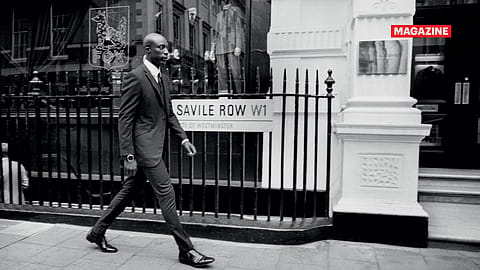A walk through Savile Row London with Mark Henderson
When centuries-old craftsmanship meets quiet evolution in the heart of London.

This story belongs to the Fortune India Magazine global-brands-indian-sheen issue.
YOU COULD BE forgiven for thinking very little had changed on Savile Row in the past 50 years and perhaps even the past 200. The first tailoring houses moved onto the Row at the start of the 19th century, and some of them are still there — at No. 1 Gieves & Hawkes (Hawkes’ founded in 1771, Gieves in 1785), at No. 10 Dege & Skinner (1865), at No. 11 H. Huntsman (1849), at No. 15 Henry Poole (1806), and at No. 16 Nortons (1821).
All along the street, tailors can be seen working in much the same way as they have done for two centuries — some even seated on their benches, cross-legged. The work rooms filled with people working — with paper patterns annotated with client notes and with bundles of cloth ready for making up. Most Houses work with a single individual making up the garments [a coat-maker, a trouser maker and sometimes that rare specialist a vest (or waist-coat) maker]; they may have specialist finishers and all work under the supervision of the cutters who meet the client, discuss their needs and then draft and cut the pattern.
Clients are seen by appointment either on The Row or when the cutters and sales teams travel on “Trunk Shows” across the world. The commissioning of a garment will involve three or four appointments — the initial appointment, a first baste (where a loosely stitched outline of the garment will be fitted), a forward baste (where the fit is finalised, buttonholes positioned and so on) and the final appointment when the garment is checked to be perfect. There will be 50-60 hours of craftsmanship put into each garment — more depending on the choice of cloth.
So, what has changed in the past 50 years (and, indeed the past 200)?
Firstly, ready-to-wear and made-to-measure have become the mainstream ways of buying tailored clothing. Gieves introduced its first ready to wear collection in the 1920s (initially kept in cupboards and taken out when clients were in too much of a hurry for bespoke and were of a fairly regular build); and made-to-measure followed where garments are factory-made with adjustment to the standard fittings (block) made prior to assembly.
Secondly, new players have emerged — in the 1960s Tommy Nutter lit up the street with his extravagant cuts and star client list; although Nutter’s business no longer survives, two of his cutters Edward Sexton and Joe Morgan (Chittleborough & Morgan) went on to found their own businesses which are now established members of the Savile Row community. In the 1990s Ozwald Boateng and Richard James developed their eponymous businesses on the Row; and in 2001 Richard Anderson set up his eponymous business at No. 13, with business partner Brian Lishak.
Thirdly, some 80 years ago womenswear began to be produced on Savile Row — with Hardy Amies setting up his couture fashion house at No. 14 (Now the HQ of Hackett) in 1945. Now many of the houses offer sublimely tailored women’s tailoring. Most recently Daisy Knatchbull has opened her business — Knatchbull — at No. 32 Savile Row with a superb made-to-measure offering.
More Stories from this Issue
And, fourthly, Savile Row sits at the very epicentre of how men’s fashion has evolved in the past 200 years — from the simple pairing of the cloth for trousers and coat (or jacket) to the development of the morning suit, evening wear — initially white tie but developing to black tie and the short dinner jacket (or Tuxedo). When the Prince of Wales of the time asked Henry Poole to cut a short coat without tails for him, it led to the “business” suit (or, simply suit) that forms the core of many men’s wardrobe. Great coats, bridge coats and blazers are all rooted in Savile Row.
So, much has changed but much has not. The great old Houses continue to thrive and prosper. True Savile Row Bespoke tailoring remains unchallenged as the very best tailoring in the world. Apprentices still form the back-bone of the reputation of this street — a completed Savile Row Bespoke diploma is considered the finest tailoring qualification in the world.
With well over 100 apprenticeships completed over the past 20 years, a newly opened tailoring school (The London Academy of Bespoke) and a gradual flow of new businesses opening their doors on the Row I very much hope that in 100 years’ time someone will be saying that nothing much has changed on Savile Row!
(The author is also former chairman and CEO, Gieves & Hawkes London. Views are personal.)